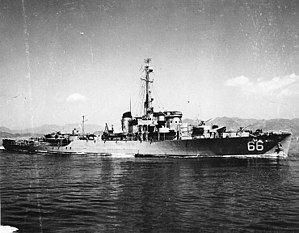Name USS Sausalito (PG-112) Yard number 47 Reclassified PF-4, 15 April 1943 Construction started 7 April 1943 Length 93 m | Namesake Sausalito, California Laid down 7 April 1943 Sponsored by Mrs. Richard Shaler Launched 20 July 1943 Builder Richmond | |
 | ||
USS Sausalito (PF-4), a Tacoma-class patrol frigate in commission from 1944 to 1945 and from 1950 to 1952, was the only ship of the United States Navy to be named for Sausalito, California. She also served in the Soviet Navy as EK-16 and in the Republic of Korea Navy as ROKS Imchin (PF-66).
Contents
Construction and commissioning
Sausalito was laid down on 7 April 1943 as a patrol gunboat, PG-112, under a Maritime Commission contract by the Kaiser Cargo, Inc., shipyard in Richmond, California. Reclassified as a patrol frigate, PF-4, on 15 April 1943, she was launched on 20 July 1943, sponsored by Mrs. Richard Shaler, and commissioned on 4 March 1944 with Commander Edward A. Eve, USCG, in command.
U.S. Navy, World War II, 1944–1945
After shakedown, Sausalito arrived at Adak, Territory of Alaska, on 5 October 1944 for convoy escort duty in the Alaskan Sea Frontier. She performed these duties until – having been selected for transfer to the Soviet Navy in Project Hula, a secret program for the transfer of U.S. Navy ships to the Soviet Navy at Cold Bay, Alaska, in anticipation of the Soviet Union joining the war against Japan – she departed on 5 June 1945 for overhaul at Seattle, Washington, to prepare her for transfer. She then proceeded to Cold Bay and began training her new Soviet crew.
Soviet Navy, 1945–1949
Following the completion of training for her Soviet crew, Sausalito was decommissioned on 16 August 1945 at Cold Bay and transferred to the Soviet Union under Lend-Lease immediately along with her sister ships USS Tacoma (PF-3), USS Hoquiam (PF-5), USS Pasco (PF-6), USS Albuquerque (PF-7), and USS Everett (PF-8). Commissioned into the Soviet Navy immediately, Sausalito was designated as a storozhevoi korabl ("escort ship") and renamed EK-16 in Soviet service. She soon departed Cold Bay bound for Petropavlovsk-Kamchatsky in the Soviet Union and served as a patrol vessel in the Soviet Far East.
In February 1946, the United States began negotiations for the return of ships loaned to the Soviet Union for use during World War II. On 8 May 1947, United States Secretary of the Navy James V. Forrestal informed the United States Department of State that the United States Department of the Navy wanted 480 of the 585 combatant ships it had transferred to the Soviet Union for World War II use returned, EK-16 among them. Negotiations for the return of the ships were protracted, but on 1 November 1949 the Soviet Union finally returned EK-16 to the U.S. Navy at Yokosuka, Japan.
U.S. Navy, Korean War, 1950–1952
Reverting to her original name, Sausalito was placed in reserve at Yokosuka. With the outbreak of the Korean War on 25 June 1950, the U.S. Navy needed additional escort vessels, and on 15 September 1950 Sausalito was recommissioned at Yokosuka with Lieutenant Commander Francis W. Deily in command. On 26 November 1950, she departed Yokosuka for Hŭngnam, North Korea. There, until 24 December 1950, she performed harbor control duties, which included escorting ships through the mineswept channel, passing instructions to ships entering the harbor, patrolling the entrance against hostile craft and drifting naval mines, and conducting shore bombardment when required.
Between February and May 1951, Sausalito's assignments included escorting the battleship USS Missouri (BB-63) on her shore bombardment station, blockade patrols, shore bombardment on the east coast of North Korea from Wonsan to Chongjin, and harbor control duty at Wonsan, broken by periods of upkeep at Sasebo and Yokosuka, Japan. Between June and August 1951, she escorted underway replenishment groups off the Korean coast.
After drydocking and upkeep at Yokosuka, Sausalito departed for the Philippine Islands in October 1951. In late November and early December 1951, she conducted a patrol against unauthorized fishing vessels in the Sonsorol Islands in the western Caroline Islands, apprehending one vessel. After spending Christmas 1951 in Subic Bay on Luzon, she made a good-will tour to Saigon, South Vietnam; Bangkok, Thailand; Singapore; and Penang, Federation of Malaya. February 1952 found her back in Korean waters, where she resumed escort and patrol duties before returning to Yokosuka for the last time under the United States flag on 31 May 1952. The U.S. Navy decommissioned Sausalito on 9 June 1952.
Republic of Korea Navy, 1952–1973
On 4 September 1952, the United States transferred the ship, on loan, to the Republic of Korea for service in the Republic of Korea Navy as ROKS Imchin (PF-66). She replaced another Tacoma-class patrol frigate, the South Korean ship ROKS Apnok, ex-USS Rockford (PF-48), which had been irreparably damaged in a collision on 21 May 1951.
Imchin was scrapped in 1973.
Awards
The U.S. Navy awarded Sausalito six battle stars for her Korean War service.
